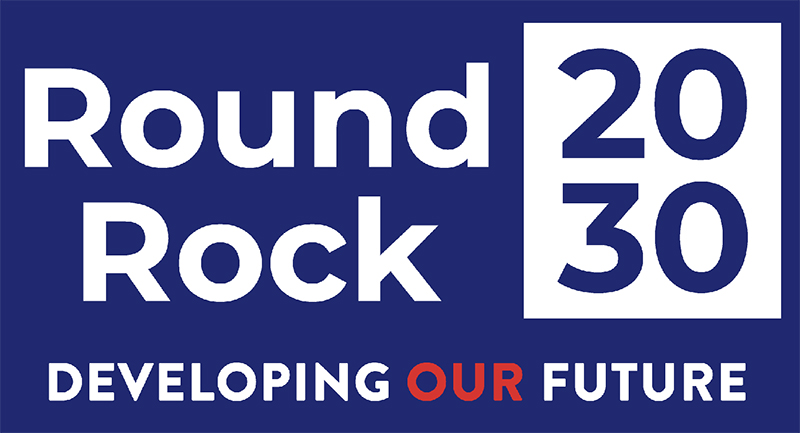ABOUT ROUND ROCK
ABOUT ROUND ROCK
About Round Rock
Round Rock, Texas is one of the fastest growing cities in America, with a population of almost 120,000. It is 37.7 square miles in area with another 29.6 square miles in its extraterritorial jurisdiction (ETJ). Much of the housing stock in the area consists of single-use subdivisions that connect to arterial roadways. Until a few decades ago, Round Rock was a small, rural community. Today it is the second-largest city in the five-county Austin-Round Rock metro area. The city is home to the Round Rock Express Minor League baseball team and soon-to-be-open attractions including the Round Rock Amphitheater and Kalahari Resorts conference center, hotel, and water park.
Round Rock is recognized as a driving force for economic development in Central Texas. The city is home to Dell Technologies’ world headquarters and businesses ranging from Emerson Automation Solutions and Dupont Photomasks to microbreweries and a honey producer. Recently a cluster of health care facilities has developed in the northeast area of the city adjacent to a trio of higher education branch campuses including Austin Community College, Texas State University, and Texas A&M University’s Health Sciences Center.
Round Rock 2030 includes a Demographic Profile, a Housing Profile, and an Economic Profile based on data available on January 1, 2020. Below is a snapshot of the data provided in the Plan.
October 1, 2021 Data Update: On October 1, 2021, Planning and Development Services (PDS) released the 2020 Census Release Report. This report provides 2020 Census data compared to 2010 Census data for Round Rock. The Census establishes a baseline for the city’s population estimates and projections. This report does not amend Round Rock 2030, however this new data may be used in future analysis.
Regional Context
Round Rock, Texas is a mid-sized city in Central Texas and the second largest city in the Austin-Round Rock Metropolitan Statistical Area (MSA). Most of the city is located in Williamson County with its southern portion in Travis County. The city is surrounded by other suburbs, with Austin to the immediate south.

Demographic Profile
Round Rock was historically an agricultural community that, as recently as 1970, had a population of less than 3,000 people. The city has since grown dramatically to almost 120,000 residents. In only the last ten to fifteen years, Round Rock has transformed from a bedroom community to an employment center in its own right, with a growing center of health care education, destination retail, and an increasing number of regional entertainment and tourism attractions. In the next decade, Round Rock’s population is expected to grow by 40,000 in the city limits to a population of approximately 160,000.
The city’s growth trajectory suddenly changed in the 1970s. Two factors contributing to this change were the completion of IH-35, which brought Round Rock within commuting distance of Austin, and the city securing a water supply capable of serving the additional residents.
Projected Growth
The City of Round Rock relies on the decennial Census for a population count that serves as the baseline for its estimates and projections. When the 2010 Census was released, PDS released population projections to 2030 for the city and Greater Round Rock. “Greater Round Rock” population estimates and projections include the total population in the ETJ and the city limits. The ETJ consists of areas outside of the city limits, including certain municipal utility districts (MUDs).
Population Growth (2020 data)
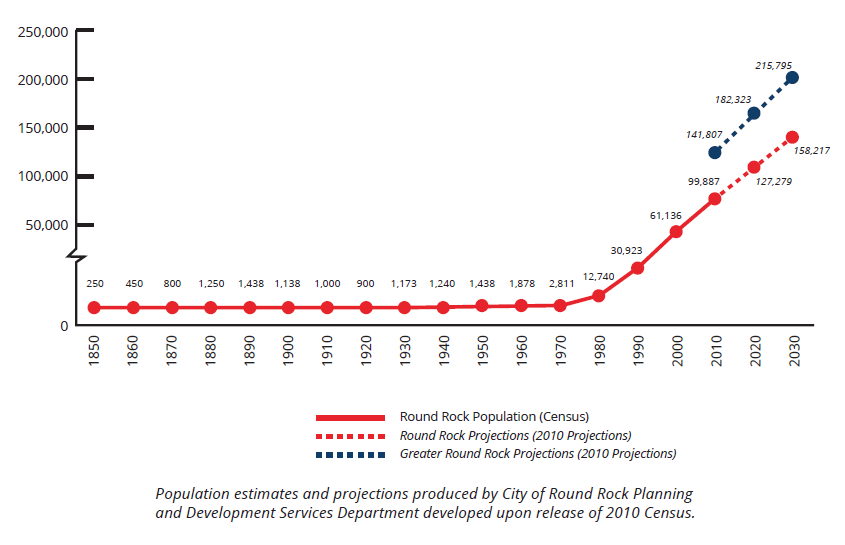
Population Comparison (2020 data)
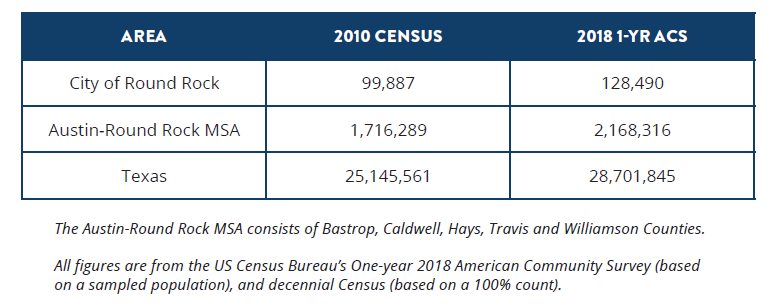
Population Estimates
PDS develops its own monthly and annual population estimates. The City of Round Rock calculates monthly population estimates using the most recent decennial Census as a baseline. Estimates are updated as Certificates of Occupancy are issued for new housing units and when annexations expand the city limits. The next Census will be collected in 2020, and data will not be available until after the publication of Round Rock 2030.
To access demographic data other than population, PDS refers to the Census Bureau’s annual release of American Community Survey (ACS) data. Estimates of total population for the ACS are released in advance of other demographic data; therefore, the most current data available is presented.
The July 2018 ACS estimated Round Rock’s population to be 128,490. Unlike the decennial Census, the ACS estimates population, housing and economic characteristics based on surveys sent to a sampling of households.
The city’s population estimates trended lower than the ACS as the decade progressed. While the city population has been growing more slowly than initially projected, permits for new housing units indicate estimates should readjust to the projected population. Over 6,500 residential units are currently under construction or in the planning phases, many with estimated completion within the next two years.
Housing Profile
Housing development has continued its pace of growth over the last several decades. From 2010 to 2018, the total number of housing units increased by over 8,500 units, or 24%. The majority of all units in the city, approximately 72%, are single-family structures.
More than half, approximately 54%, of housing units are owner-occupied. The median owner-occupied home price has also increased significantly, from $165,800 to $269,300 in nominal terms, or from $190,545 to $269,300 in real terms.
Approximately 6,500 housing units are currently in planning or development, almost 3,000 of which are expected to be completed within the next two years.
Affordability is a significant issue for a large number of renters. Nearly half of renting households spend more than 30% of their income on gross rent, a level that is considered cost-burdened by the US Department of Housing and Urban Development.
Units in Development (2020 data)
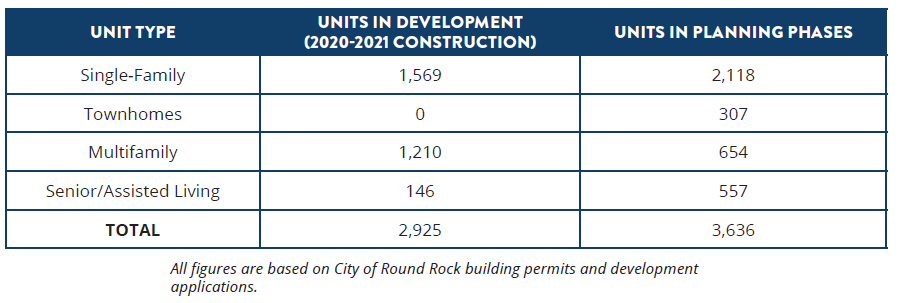
Housing Cost (2020 data)

Economic Profile
Round Rock has transitioned from a bedroom suburb of Austin to an employment center of its own, with a labor force of 71,254 people in a vibrant and diversifying economy. Dell Technologies, still the city’s largest employer with approximately 12,000 employees, recently celebrated its 25th year in Round Rock. In that time, the city’s economic base has diversified with growth in specialty manufacturing, health care and health sciences education, hospitality and regional tourism.
Known as the Sports Capital of Texas, Round Rock is home to the Round Rock Express minor league baseball team, and promotes itself as a destination for youth and amateur sports. Kalahari Resorts has chosen to build its newest facility in Round Rock which includes a conference center, water park and 975-room hotel.
According to the Bureau of Labor Statistics, job growth in the Austin-Round Rock MSA has been greater than three percent every year since 2011. The city’s rapid economic and population growth have coincided with equally rapid land development. In 2018, Round Rock’s total taxable property value was $13.6 billion, and an estimated $367 million has been added in the year since then.
Commissioned by the city and the Chamber of Commerce, the 2017 Garner Economics, LLC report Building Upon a History of Success: An Economic Development Action Plan for Round Rock, Texas identified several industries that the city is well-positioned to attract in the future, including life sciences and health care, technology and computing, professional and financial services, specialty small-scale manufacturing, tourism, and hospitality. The report’s Real Estate Market Competitiveness Assessment noted employer preferences are changing toward a more walkable, mixed-use physical environment, and recommended that the city encourage more of this form of development and redevelopment in the future.
Jobs by Industry (2020 data)
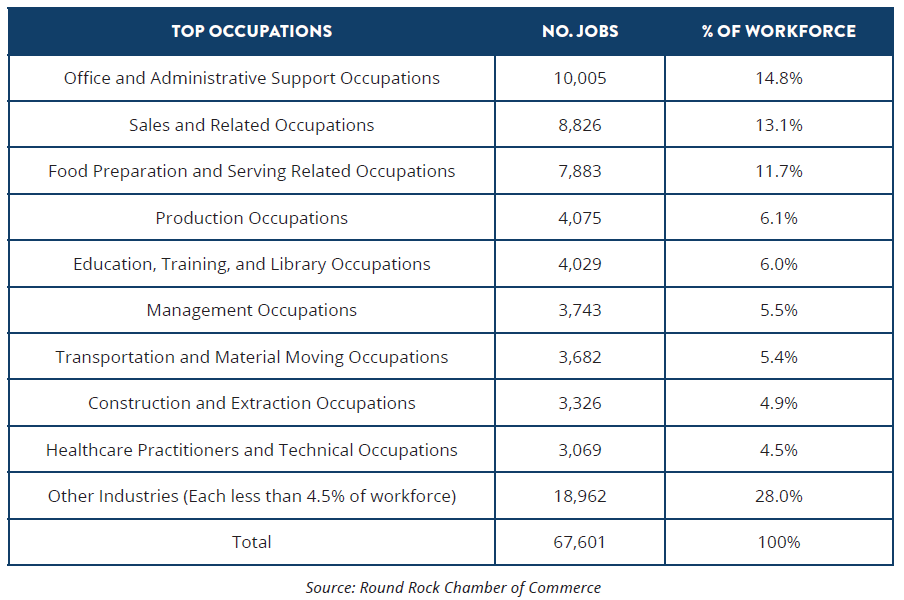
Job Growth (2020 data)
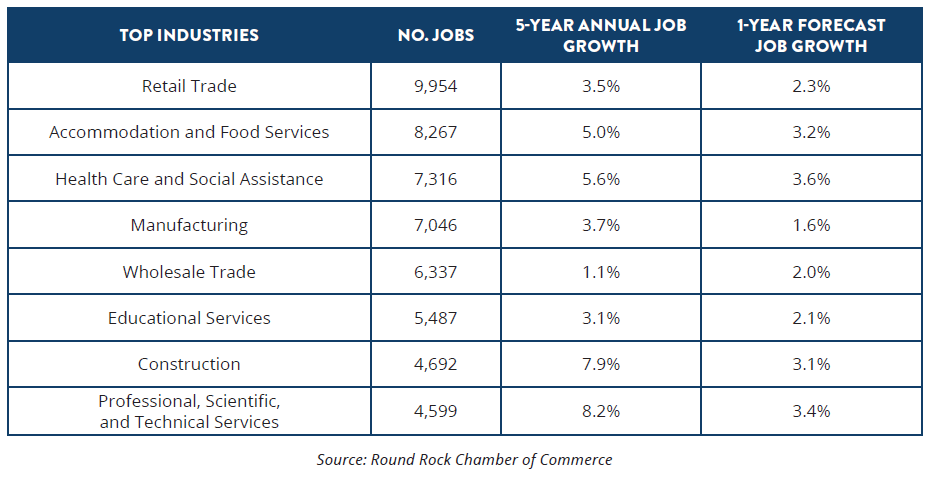
The future economic outlook for Central Texas is strong. According to Round Rock Chamber of Commerce, the economic analytics firm The Perryman Group predicted that between 2016 and 2021 the Austin-Round Rock MSA will add 131,000 new jobs, or an average of 26,000 jobs per year. This will drive demand for all types or real estate, including office, retail, apartments, and especially for-sale housing.
Accolades
Round Rock’s growth is also attributable to its quality of life, and it frequently appears on lists of best cities in the United States. In 2015, the city was named the best affordable place to live by Livability.com and America’s 3rd most affordable place in America by NerdWallet. In 2017, Round Rock was named the 5th safest city, 7th best city to buy a house, and 9th best city to raise a family by Niche. In 2019, the city was ranked 2nd on the best places to live in America by Money Magazine and one of the coolest suburbs in America by Apartment Therapy. The city also has the 10th fastest-growing local economy in the nation according to WalletHub, ranked 9th on a list of top boomtowns in 2019, and 11th on a list of most recession-resistant cities in America in 2020 by SmartAsset. Round Rock’s downtown historic district supports unique shops, bars and restaurants, with many concerts and community events. Round Rock schools have among the highest ratings in Texas, and the city has earned the moniker “Sports Capital of Texas” for amateur, youth, and recreational sports. Residents describe the community as a great place to live, work, and raise a family.
Timeline
To give a brief history of Round Rock, a timeline was included along the bottom of the pages in the introduction of Round Rock 2030.
